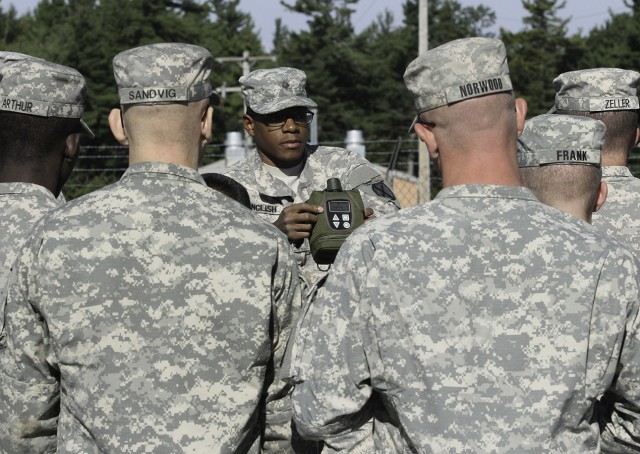FORT DRUM, N.Y. -- Nearly 30 Soldiers of 2nd Brigade Combat Team, 10th Mountain Division (LI), gathered at Fort Drum's Central Vehicle Wash Rack on Sept. 17 to conduct Chemical, Biological, Radiological, Nuclear and Explosive vehicle- and personnel-decontamination training.
The event provided Soldiers with valuable hands-on experience that will prepare them for their upcoming Mountain Peak exercise at Fort Drum and a rotation to the Joint Readiness Training Center at Fort Polk, La., said 1st Lt. Sean Flanagan, chemical officer, Headquarters and Headquarters Company, 2nd Brigade Special Troops Battalion.
Soldiers began the training event by decontaminating Humvees and military excavation equipment using a process called "vehicle wash down."
"The vehicle decontamination lane has five stages," Flanagan explained. "The initial wipe down, scrub down, 30-minute wait time, interior decontamination, final rinse and then you have your final chemical checks."
During stage one, vehicles received a high pressure blast of hot, soapy water, sprayed in a top-to-bottom motion that rinses chemicals from the surface, Flanagan said. Once saturated, a team of Soldiers, using the same top-to-bottom motion that prevents cross contamination, scrubbed the vehicle with stiff-bristled brushes and allowed the soap solution to penetrate chemical contaminates for 30 minutes.
Stages three and four consisted of stripping the vehicle of all interior components and receiving a final rinse.
Flanagan said the process is finished when Soldiers ensure the equipment is free of contaminates by "sniffing" the air around the vehicle using the Improved Chemical Agent Monitor designed to detect trace amounts of chemicals on personnel and equipment.
If the Soldiers find no chemical traces, the decontamination process is complete. If there are trace elements detected the Soldiers will repeat the process, she added.
"Simultaneously, while that is going on, we are doing a Mission Oriented Protective Posture exchange," Flanagan said.
While donning the suit is a relatively harmless procedure, removing it safely after being exposed to potential contaminants must be done carefully.
Spc. Deron English, a CBRNE specialist assigned to HHC, was on hand to teach Soldiers how to remove contaminated suits properly.
"Today I taught the MOPP exchange," he said. "I taught them how to get out of the suit once they've been in a contaminated area."
English added that life expectancy of a contaminated suit is 24 hours, and he stressed the seriousness of exchanging equipment before the zero hour.
Ensuring that no contaminants touched the clothing or skin beneath their JLIST, Soldiers assisted each other in removing their suits using the buddy team method. Once the Soldiers put on sterile equipment, they gain another 24 hours of protection and they are able to complete the MOPP exchange process, English said.
Flanagan said she believes that CBRNE training will help prepare Soldiers for unexpected situations.
"I think this training helps the brigade tremendously because it's something we have never really done before," she said. "I think this will be kind of a wakeup call … because heaven forbid we have something come up and we have no one trained for it."






Social Sharing